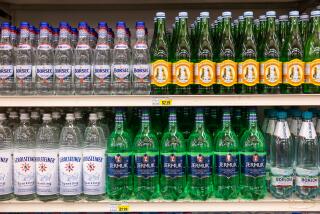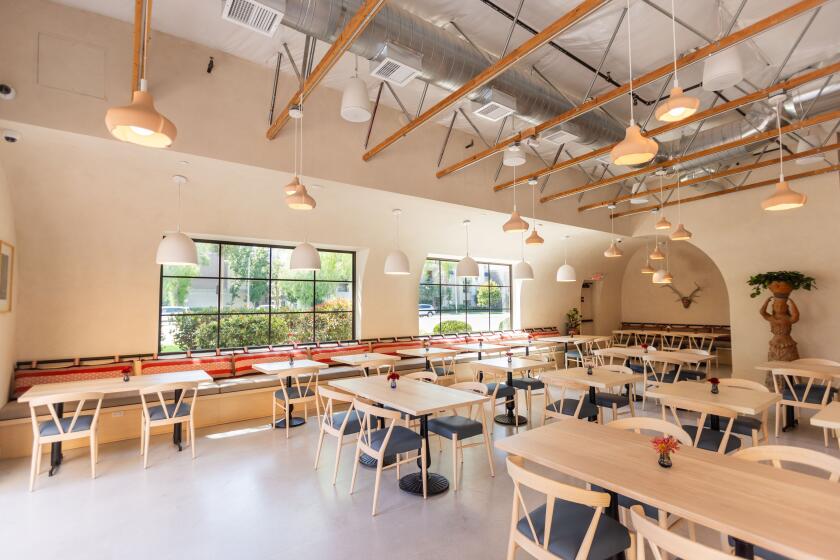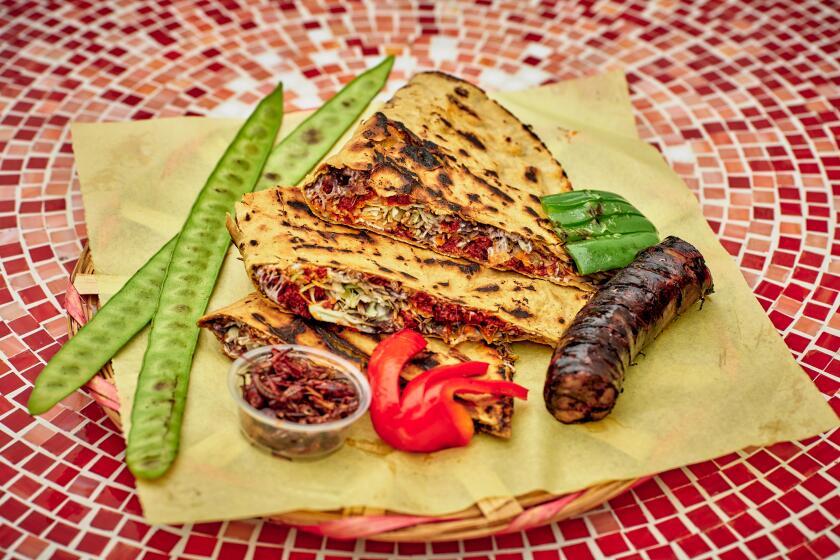Old Wine in New Bottles
SONOMA, Calif. — Within the next few weeks, you will begin seeing a new wine on the shelf that may look familiar. The name of the wine is Haywood Vintner’s Select, and it will be a Chardonnay selling for about $8.
You might try it, especially considering that discounts may put the price for it closer to $6. I think you’ll find it an excellent value. The 1990 Vintner’s Select has a lovely tropical fruit and citrus aroma and perfect balance. It is dry and finishes crisp on the palate.
What the label fails to say is that this wine is part of a major restructuring for the Haywood Winery, a decade-old producer of top-quality wines that normally cost a lot more than this Chardonnay. The wine follows the acquisition of the Haywood brand a few weeks back by Buena Vista Winery and the move of Haywood into the Buena Vista facility.
Steve Cousins, president of Buena Vista, said that part of Buena Vista’s strategy was “the acquisition of top brands, which is part of our growth plan.” By buying Haywood, Buena Vista also got one of the best Zinfandels in the state, he said.
“We (desire) products that are unique and of high quality, and we want to be competitive at various price points. We believe that Haywood Zinfandel is one hell of a . . . wine.”
Haywood Zinfandel, which sells for $14, is one of the most expensive in California, but it is a wine in wide demand. It was the Zinfandel that attracted Marcus Moeller-Racke, former president of Buena Vista, to the Haywood brand, just as he also was intrigued enough by Robert Stemmler Pinot Noir two years ago to buy that brand.
The Haywood deal also gave Buena Vista a chance to create the Vintner’s Select Chardonnay, which is aimed at competing directly with Fetzer’s successful Sundial Chardonnay, of which about 200,000 cases are sold annually. There are just 25,000 cases of this first release of the Haywood Vintner’s Select, “and we believe that if we . . . maintain this quality and this price point . . . there’s an opportunity to market 200,000 cases,” said Cousins.
Peter Haywood is ecstatic over the deal. With all wine sales in the United States flat due to lower consumption and rising prices, Haywood found his sales increasingly difficult. Although his wines were excellent, Haywood lacked marketing clout. Selling the brand to Buena Vista was the logical decision, he finally realized. He remains a partner in the brand and will sell the grapes off his own vineyards (which he retained) to Buena Vista for the Haywood wines.
A former building contractor who grew tired of standing in lines for permits, Haywood began his winery to switch to the agrarian life. His wines were successful--elegant Chardonnays, gutsy Cabernets, fragrant Rieslings, potent Zinfandels.
“But I could never get to a point of real profitability,” said Haywood. “I’d make money one year, then I’d break even the next.”
The lure of higher production was just an illusion of success, he said. A decade ago, when he was producing 15,000 cases a year, he thought that if he could make 30,000 cases, he’d surely make money. So in 1987, he made 35,000 cases of wine.
“And I sold only 23,000 cases,” he said. All the wine eventually sold, but at discounted prices and at the expense of his other wines.
Moreover, he had to cut back production in later years while his costs rose. “And when you’re on a banker’s short tether, it’s hard to make decisions that help your bottom line.”
Haywood was caught in a typical squeeze. At 15,000 cases, the winery was marginally successful. At 30,000 cases the profit didn’t rise because all costs were higher and margins smaller. Also, twice the amount of grapes had to be paid for well in advance of the time the wine was sold.
Haywood pointed out that in 1982, he sold his first Chardonnay for $11.50; this year, his Chardonnay was $12.50. “In the next few years, I think we’ll see a lot of buyouts, mergers and marketing arrangements for wineries that got into the slot I was in,” he said.
“This deal means I won’t have to come into the winery every Monday and count cases,” said Haywood.
“Every winery faces pressure for cash. It’s not really the responsibility of the banks. The bank is a convenient teddy bear to beat on, but it’s not all their fault. This industry is notorious for not being able to collect payments (on wine shipped). I’ve gone 70 to 110 days before I get paid. But your suppliers expect to get paid in 30 to 60 days.”
The top Haywood wine remains Zinfandel, a stunningly deep and spicy wine with raspberry and pepper overtones and a rich, rewarding burst of fruit in the finish. It is made from a clone of Zinfandel “that has a fairly large berry and was supposed to produce a large yield,” said Haywood. “But our hillside is steeply terraced, from 300 feet (above the valley floor) to 700 feet, and the yields are very low.” This gives more concentrated flavors.
Under Buena Vista, the top-end Haywood wines will remain good values. Haywood’s wine maker, Sara Steiner, was hired by Buena Vista and will continue to make the Haywood wines, but at the Buena Vista winery in the Carneros. (Haywood’s former partner, Rudy Tulipani, bought the Haywood facility from the partnership and has leased it, with an option to buy, to Joel Peterson of Ravenswood, who moved into the facility in February.)
The agreement calls for the Haywood line to be reduced to just Cabernet Sauvignon, Chardonnay and Zinfandel, all from Haywood’s Los Chamizal Vineyard. Marketing will be done by Buena Vista, an American subsidiary of A. Racke, a diversified German company.
Wine of the Week
1990 Callaway White Riesling ($6.75) --Callaway wine maker Dwayne Helmuth has made some excellent white wines at his Temecula winery in the past few years; this one is a delightful off-dry wine, perfect with Thai food or other slightly sweet dishes, including fruit salads. Its residual sugar is 1.7%; this is balanced by excellent acidity. The one complaint is that the sugar content isn’t on the label; nor is there any description of how sweet the wine is.
More to Read
Eat your way across L.A.
Get our weekly Tasting Notes newsletter for reviews, news and more.
You may occasionally receive promotional content from the Los Angeles Times.










